 |
JLab Gets DOE Nod on $310-Million Upgrade Project |
 |
Arne Freyberger Becomes New Director of Operations |
 |
Jefferson Lab Boasts Virginia's Fastest Computer |
 |
'Tis the season for eCard scams |
 |
Energy Savings Deeply Rooted At Jefferson Lab |
 |
JAG Sponsors Holiday Events for Young, Young at Heart |
 |
Evening Lecture Celebrates 50th Anniversary of the Laser |
 |
Employee Discounts Available for Microsoft Products |
 |
Milestones: October through November 2007 |
JLab Gets DOE Nod on $310-Million Upgrade Project
The proposed $310-million project that will double the energy of the electron beam at Jefferson Lab achieved a critical milestone on Nov. 9, when the Department of Energy approved the project's performance baseline.
The approval, known as Critical Decision 2 (or CD-2, Approve Performance Baseline), caps years of planning, preparation and review. According to DOE, CD-2 authorizes the final design phase to begin and is required prior to requesting a project's construction funding in a federal budget.
"The approval of CD-2 marks a significant achievement for Jefferson Lab," said Dr. Jehanne Simon-Gillo, the Acting Associate Director for the Office of Science for Nuclear Physics. "The 12 GeV Upgrade Project will allow nuclear scientists to delve deeply into the heart of the nucleon and will permit Jefferson Lab to remain a unique international facility for decades."
CD-2 is the third step in a five-step process. The final two steps are CD-3, Approve Start of Construction (scheduled for 2008), and CD-4, Approve Start of Operations (scheduled for 2015).
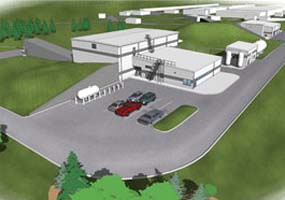
This architectural rendering shows the Hall D complex to be built as part of the CEBAF 12 GeV Upgrade at Jefferson Lab. Rendering by Hayes, Seay, Mattern & Mattern, Inc.
The doubling of Jefferson Lab's energy, from a 6-billion-electron-volts (GeV) to a 12-GeV accelerator, building of a fourth experimental hall and making improvements to the existing experimental halls, will provide scientists a one-of-a-kind tool for seeing more clearly into the nucleus of the atom and its protons and neutrons. Jefferson Lab is already the most-precise facility of its kind in the world for exploring the subatomic particles known as quarks and gluons that make up protons and neutrons. In particular, the upgrade will enable scientists to address one of the great mysteries of modern physics: Why are there no single quarks?
"Securing CD-2 is a tremendous accomplishment for Jefferson Lab and the members of our 12 GeV team. This milestone further solidifies the Lab's standing as a preeminent nuclear physics research facility. Most importantly, our nation has moved a step closer to providing scientists worldwide with a tool that will enable us to expand our knowledge of the universe," said Christoph Leemann, Jefferson Lab's Director.
To explore protons and neutrons, JLab's accelerator propels a beam of electrons at nearly the speed of light around a massive underground one-kilometer racetrack. When the beam smashes into experimental targets, huge detectors collect the fragments. By studying the speed, direction and energy of the scattered fragments, scientists can learn more about protons and neutrons.
Arne Freyberger Becomes New Director of Operations
by Judi Tull
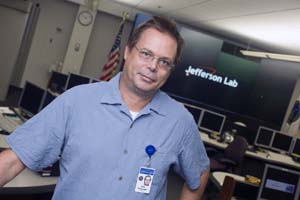
Arne Freyberger, the new director of operations for CEBAF, pauses for a moment in the CEBAF control room.
Arne Freyberger remembers, almost to the moment, when he chose physics as his life's work.
"I was always taking things apart as a kid," he recalled. "I was always into radios and electronics." But it was a PBS show on particle physics that really turned his head. "I decided right then that I would make physics my career. From the moment I made that decision, there was never any deviation from that goal."
His dedication to the field was rewarded when, on Oct. 1, he became the new director of operations for the Continuous Electron Beam Accelerator Facility after an exhaustive eight-month search that included numerous internal and external candidates. The selection was made by a cross-divisional team, with input from senior Lab management, the Physics Division, Users and the group leaders in the Accelerator Division's Operations Department. Although Freyberger admits that the position had not been on his radar as a career step, he took the encouragement of his peers to heart and threw his hat in the ring.
The path that brought him to this position started with that inherent interest in physics instilled during his childhood in New Jersey. His home was close to Manhattan and his family spent summers at the Jersey Shore, where he also fell in love with surfing, a hobby he still pursues. After graduating from high school, it was on to Rutgers, where he was Phi Beta Kappa and received his bachelor's degree in physics and math in 1983. Then it was on to Carnegie Mellon, where he served as a research assistant and was selected for Sigma Xi scientific honor society, and earned his master's in physics in 1985 and his Ph.D., also in physics, in 1990.
As a postdoctoral fellow, he worked on the CLEO experiment at Cornell, where he developed kinematic fitting and other general-purpose analysis software for the collaboration.
He first came to Jefferson Lab in 1994 and worked on all aspects of the Hall B commissioning. In 2002, he decided it was time for a change and moved to the Accelerator Division, working with the beam diagnostic equipment. "I was intrigued by the opportunity to be involved with something I hadn't done before," he said.
Since that time, he became the coordinator for the 12 GeV Beam Physics Design effort, and supervised five scientists and one graduate student.
"I became more and more involved in understanding the CEBAF machine and became a more integral part of the day-to-day operations," he noted. "It can be a love/hate relationship: hating when there's a problem that needs to be fixed, but loving the satisfaction of finding the right solution."
His new position as the director of operations presents him with a unique opportunity. "What's going to be interesting for me is merging my scientific knowledge and capabilities with a management style I'm still forming," he said.
Freyberger lives in the Tabb area of York County with his wife, Theresa, an English teacher at Tabb High School, and his sons, Dylan and Miles. The family also has a house at the Outer Banks, where he continues to indulge his lifelong passion for surfing, although, as he noted with a laugh, "I was much better when I was younger."
He's also an inveterate bike rider, and makes an effort to turn his five-mile ride from home to the Lab into a 10- or 15-mile jaunt by taking a meandering route.
In many ways, being at the Lab and being the new director of operations are the ultimate fulfillment of the dreams he had as a youngster. "As a physicist," he noted, "you're either going to be faculty somewhere or at a lab. It's exciting to be where the great science is going on."
Jefferson Lab Boasts Virginia's Fastest Computer
by Kandice Carter
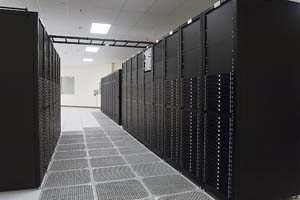
The supercomputer, dubbed 7N, is a cluster computer composed of individual units wired together to function as one. It is built of 396 nodes, or individual computers.
This is Jefferson Lab's first appearance on the TOP500 list. The 30th edition of the list was released Nov. 12 at SC07, the international conference on high performance computing, networking, storage and analysis, in Reno, Nev.
The Lab's supercomputer runs powerful computer simulations to shed light on how one of the basic forces of nature, the strong force, builds protons, neutrons and other particles from the basic building blocks of matter: quarks and gluons.
The supercomputer, dubbed 7N, is a cluster computer composed of individual units wired together to function as one. It is built of 396 nodes, or individual computers, each containing two Advanced Micro Devices (AMD) quad-core 1.9 GHz processors with four Gigabytes (GB) of onboard random access memory (RAM). The nodes are connected via a Double Data Rate Infiniband network, which is capable of transferring 20 Gigabits of data per second (Gb/s) between the nodes.
"With our cluster computers at Jefferson Lab, we have always taken the cost-effective way," says Jie Chen, a JLab senior computer scientist and a lead researcher in setting up and testing the supercomputer. "This listing puts Jefferson Lab on the map in the scientific computing community."

Members of the team that installed, prepared and operate the new 7N cluster computer include (back row, left to right) Sandy Philpott, David Rackley, Jie Chen, Michael Barnes, Randy Hartman and Chip Watson, and (front row, l. to r.) Ying Chen, Balint Joo and Lawrence Sorrillo. Not pictured: Christopher Miller.
The cluster was installed in Jefferson Lab's Computer Center by the members of the Lab's High-Performance Computing Group in late summer. Once installed, it more than tripled the Lab's high-end computing capabilities.
"We're proud and honored that the Department of Energy has provided this incredible resource at Jefferson Lab for our research into the fundamental structure of matter. Hampton Roads is now home to a supercomputer that's among the world leaders in scientific computing," says Jefferson Lab Chief Information Officer Roy Whitney.
The cluster qualified for the list by running the Linpack Benchmark, a calculation that's used by the TOP500 as a yardstick for supercomputer performance. The cluster ultimately clocked out at 13460 Gigaflops running solidly on 380 nodes.
'Tis the season for eCard scams
by David Bianco
JLab Cybersecurity Analyst
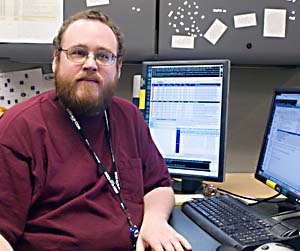 David Bianco - JLab Cybersecurity Analyst
David Bianco - JLab Cybersecurity AnalystBe wary of holiday eCard scams and cyber attacks. The holidays are here again, and with them come the yearly flood of electronic greeting card scams. As popular as eCards are with your brother Phil and your Aunt Lucy, they're even more popular with Internet fraudsters, as several JLab computer account holders have recently learned firsthand.
This year more than ever, the eCard you receive might be legit, or it might be an attempt to trick you into giving an attacker access to the information on your PC. The e-thieves' biggest targets are credit card numbers, bank account details and other information that could help them steal both your identity and your money. Worse, the eCards themselves can appear to come from legitimate sites or to have been sent by your actual friends and relatives. Telling the legitimate eCards apart from the scams can be very difficult, and guessing incorrectly can cause real problems.
So what can you do to help protect yourself (and the Lab) from this type of attack? Here are some tips:
* The most effective thing is to ignore the eCard altogether. If you don't click that link or open that attachment, the scam will fail.
* If you do not recognize the sender's address, or if the card comes from "a friend" or "a secret admirer," it's almost certainly a scam.
* If you do recognize the sender, send them an email and ask if they really did send the eCard. If so, it's probably safe to read the eCard.
* Do not rely on anti-virus software, patches or other security measures to keep your system safe from infection. Scammers are experts at getting around all types of automated security measures. You are the last, best line of defense against viruses, Trojans and scams.
When you receive one of these electronic cards (and odds are that you will), ask yourself, "Does this look suspicious in any way? " If so, simply delete the message and bask in the knowledge that you've helped maintain the Lab's cybersecurity and protected your personal information.
If you'd like to do some additional reading on the subject, here are a few good URLs to start with:
http://www.ic3.gov/media/2007/070718.htm
http://www.technewsworld.com/story/7ujrbuLiqQvvCV/Holiday-Scammers-E-Greeting-Card-Tactics.xhtml
http://blog.washingtonpost.com/securityfix/2007/07/notsofriendly_greeting_cards_1.html
http://www.enterpriseitplanet.com/security/features/article.php/3645616
Energy Savings Deeply Rooted At Jefferson Lab
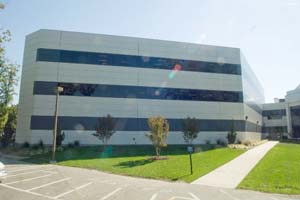
A geothermal system installed in a portion of the CEBAF Center F Wing is saving money on the Lab's utility bill.
A geothermal well system was installed to control heating and cooling on two floors of the F Wing of in CEBAF Center, the Lab's main administration building. The wing is a three-story, 61,000-square-foot addition that was constructed in 2005.
The geothermal system uses water circulated between a heat exchanger and 168 sealed wells drilled approximately 200 feet into the earth in an open grassy area adjacent to CEBAF Center. Air conditioning and heating is accomplished by 51 electronically controlled heat pumps located throughout the building.
On hot summer days, the pumps remove heat from the building and pump it into the wells, where it is absorbed by the soil and retained. On cold days, the process is reversed, and the heat stored in the soil is used to warm the building. A home equipped with the same process could reduce its energy bill by 70 percent a year.
JLab also conserves energy by controlling the volume of fresh air pumped into F Wing, with the volume determined by occupancy. Fewer people need less fresh air that is heated or cooled. Also, the air that is exhausted from F Wing is processed through a special device that transfers heat from the waste air stream to the fresh air stream, thus saving more energy. The system operates very effectively most of the year; however, there are very hot and humid days when this process must be augmented by mechanical cooling.
The geothermal system was proposed by staff working in the Lab's Facilities Management department. It was one of four options considered, and it was selected because calculations proved it would be the most energy efficient, costing $500,000 less over its lifetime than the next lowest life-cycle cost option.
Most importantly, the system is saving the Lab more than 515 million BTU (British Thermal Units) of energy per year, or about $7,600 a year. That's the equivalent of about 23 tons of coal or roughly 3,900 gallons of heating oil.
JAG Sponsors Holiday Events for Young, Young at Heart
Join the fun! The Jefferson Lab Activities Group is sponsoring events and activities to celebrate the season.
Children Invited to Winter Wonderland Party

The Jefferson Lab Activities Group is hosting a children's holiday party on Saturday, Dec. 8 from 10 a.m. to 1 p.m. in the CEBAF Center lobby. All children of Lab employees, contractors and Users are invited.
Santa Claus plans to drop in on the Winter Wonderland Party, and will be available to talk with and be photographed with the children. Youngsters may take part in games and craft activities. Light snacks and drinks will be provided. All children must be accompanied by an adult. Each family is asked to bring a new, unwrapped toy donation for Toys for Tots.
Help With Children's Party
Nearly two dozen volunteers are needed to help with the event, mostly as crafts-table and game helpers. (All crafts and supplies will be provided. Volunteers will need to assist younger children with basic cutting, gluing or tying.) Volunteers are also needed for the snack area and as Santa's Helpers. Sign up now to help http://www.jlab.org/intralab/committees/jag/current.html .
Toys for Tots Toy Drive Gets Underway
As in years' past, JLab is participating in the U.S. Marine Corps' annual Toys for Tots toy drive. Bring in your donation of new, unwrapped toys for children ages 1-12 by 4 p.m. Friday, Dec. 7. Local Marines will pick up the toys during the children's holiday party on Saturday, Dec. 8, and distribute them to children in need. Marked drop boxes are located near the main entrances of CEBAF Center, VARC, ARC, Test Lab and the MCC. For information about the Toys for Tots program, visit www.toysfortots.org .
Ready, Set, Hang Those Decorations

JAG is also sponsoring a Holiday Office Door/Cubicle Decorating Contest. Prizes will be awarded for the Best Decorated, Most Original Decoration, and the Silliest. All employees, Users and contractors with an office or cubicle may enter the contest. To enter, you must email JAG Chair Dave Williams at williamd@jlab.org by 5 p.m. Dec. 14. Include your name(s), building number and office/cube location. Judging will take place Dec. 17 and 18 and the winners will be announced on Dec. 20.
Decorations may go up as early as Dec. 3 and should be taken down by Jan. 4. Decorating materials should be fire resistant and only UL-approved lighting/electronics may be used. Please don't use food-based items in your decorations.
"Plan on being part of the fun and festivities," Williams urges. "Mark your calendars. Look for the JAG fliers in your work areas, visit our webpage or contact a JAG committee member for more information."
For more information, contact JAG at jag@jlab.org or visit www.jlab.org/intralab/committees/jag/ .
Evening Lecture Celebrates 50th Anniversary of the Laser

The Tuesday, Dec. 4, Science Series lecture at JLab will feature Michelle Shinn, the Free-Electron Laser Division's chief optical scientist, celebrating 50 years of the laser by conducting demonstrations with light and discussing recent advancements with the laser.
There was a time not so long ago that the laser was "a solution looking for a problem," according to Shinn. Lasers are now used in many facets of everyday life - at home, work, retail, and in medicine and transportation. See demonstrations on how lasers work and how they are used; and learn about some ways they may be used in the near future.
The presentation will begin at 7 p.m., Dec. 4, in Jefferson Lab's CEBAF Center auditorium, located at 12000 Jefferson Ave., Newport News. The program is free and open to anyone interested in learning more about science. It will last about one hour and include a question-and-answer period at the end.
Enter at Jefferson Lab's main entrance (Onnes Dr.). Everyone over 16 is asked to carry a photo ID. Security guards may perform ID, bag and vehicle checks. For directions and information about other Fall Science Series presentations, call 269-5102 or visit http://education.jlab.org/scienceseries/index.php .
Employee Discounts Available for Microsoft Products

JLab employees, Users and contractors have two options for purchasing Microsoft products for home use. Products that will be used for JLab work at home may be purchased through the Home Use Program, according to Myung Bang, a member of the Computing and Networking Infrastructure group.
"This program is strictly for people who will be using the software to support the Lab's mission from their home office," Bang stresses. "You can get a licensed copy of the same Microsoft Office desktop applications you use at work for installation and use on your home computer."
You may order a single copy of each eligible product for which you are a licensed user with active Software Assurance coverage. This software may be used as long as you are working for the Lab and as long as the software you use at work has active Software Assurance coverage. Most software purchased through the program is available for about $20. Microsoft Office 2007 is already available for purchase through this program.
Those who would like a personal copy of programs to use at home on non-work-related projects may participate in the Microsoft Employee Purchase Program. This program offers many of Microsoft's most popular products at discounted prices.
"This program allows you to buy Microsoft hardware and software for home use at a discount," Bang says. "This program offers game systems, operating system software and many other products." The program allows you to purchase up to three copies of any product available.
To purchase Microsoft products through these programs, click the appropriate link in the text above and follow the instructions on the linked webpage.
Milestones: October through November 2007
Hello
Jonathan Bailes, Mechanical Engineer, Engineering Division
Larry Carraway, Mechanical Tech/Machinist, Physics Division
David Chopard, Web Editor, Chief Operating Officer Division
William Crahen, Hall D Mechanical Engineer, Physics Division
Albert DeChristopher, Procurement Administrator, Office of the Chief Financial Officer
Alan Lewis, CNC Machinist, Engineering Division
Stephen Mano, Mechanical Designer, Engineering Division
Vladislav Razmyslovich, Mechanical Designer, Engineering Division
Sharon Williams, Procurement Administrator, Office of the Chief Financial Officer
Daniel Young, Hall C Mechanical Coordinator, Physics Division
Goodbye
Shannan Kyte, Electronic Media Manager, Information Technology Division
Diane Sarrazin, 12 GeV Upgrade Administrative Assistant, 12 GeV Upgrade Project
Barbara Swanick, Procurement Administrator, Office of the Chief Financial Officer
Ross Young, Post Doctoral Fellow, Office of the Chief Scientist
These Milestone entries, listed alphabetically, are actions posted by Human Resources during October and November, 2007. Current JLab career opportunities are posted at: http://www1.jlab.org/mis/jobline/

